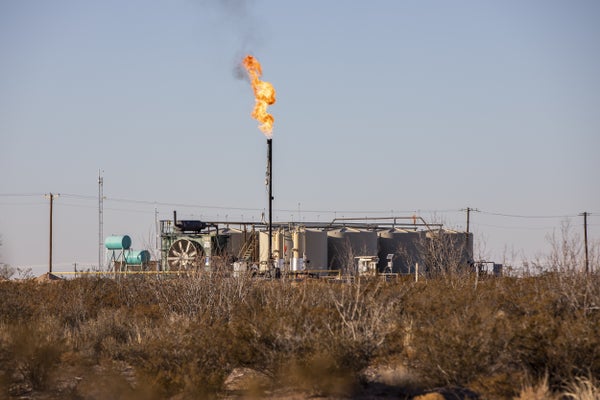CLIMATEWIRE | Helium concentrations are rising in the atmosphere, according to new research that confirms a long-held suspicion about the byproduct of fossil fuel production.
The findings—published Monday in the journal Nature Geoscience—are yet another indicator of the world’s reliance on fossil fuels. Helium isn't a greenhouse gas, but it is a byproduct of the production of fossil fuels, particularly natural gas.
The study’s findings may seem obvious. But for years, scientists have had some difficulty demonstrating that helium levels are actually increasing alongside greenhouse gas. It can be tricky to look directly at helium concentrations in the air and determine whether they’re rising over time, and previous studies have produced conflicting results.
On supporting science journalism
If you're enjoying this article, consider supporting our award-winning journalism by subscribing. By purchasing a subscription you are helping to ensure the future of impactful stories about the discoveries and ideas shaping our world today.
“People have been discussing this for decades now and not come to a conclusion,” said Benjamin Birner, the study’s lead author and a postdoctoral researcher at the Scripps Institution of Oceanography at the University of California San Diego.
To help settle the long-standing question among atmospheric chemists, Birner and his co-authors used a new, more precise method for assessing helium concentrations in the air.
Using air samples collected around the world over the last 50 years, the researchers compared the ratio of helium to nitrogen in the atmosphere. It’s well-established among scientists that nitrogen levels have remained fairly constant. If the ratio of helium to nitrogen shifted over time, then they could conclude that helium concentrations have changed.
Helium can be released in several different forms, or isotopes. The researchers focused specifically on helium-4, the isotope that’s released in the greatest volumes during fossil fuel production.
They found that helium-4 is, indeed, rising in the atmosphere.
Ray Langenfelds, an atmospheric scientist at Australia’s Commonwealth Scientific and Industrial Research Organisation, said more questions remain.
“Earlier studies on atmospheric helium trends had produced conflicting results, leaving open questions about what the true fossil fuel impact on helium had been,” Langenfelds, who was not involved in the study, said in an email to E&E News. “This new paper brings new information that will bring us closer to resolving the outstanding questions, but not everything is settled just yet.”
One mystery ends—and another begins
The scientists also looked at another isotope, helium-3. Helium-3 is also a byproduct of fossil fuel production, but most studies suggest it’s released in much lower quantities than helium-4.
Helium-3 has potential as a fuel for nuclear fusion, which is often touted as a potentially near-limitless source of clean energy (though the industry is far from commercial viability). It is scarce and has raised periodic concerns about global shortages.
But when the researchers examined data on the ratio of helium-3 to helium-4 in the atmosphere, they found that helium-3 appears to be increasing at a rate much higher than expected.
There are other sources of helium-3 besides the fossil fuel industry. It’s also a byproduct of nuclear activities, including the global stockpile of nuclear weapons and the generation of nuclear power. But even those sources can’t fully account for the increase in atmospheric helium-3.
So where is it coming from? For now, researchers are mostly stumped.
“One option is that there is a lot more helium-3 in natural gas than previously thought,” Birner said. “Or we are missing something else. But I really don’t know what that might be.”
The study’s findings of helium-4, however, are more clear, and could open up a new method for monitoring greenhouse gas emissions from fossil fuels.
Because helium is mainly associated with the natural gas industry, keeping tabs on its concentrations could help scientists “disentangle” emissions from natural gas versus other sources, according to Birner.
Scientists have come up with various methods for separating fossil fuel emissions from other natural emissions of greenhouse gases. Tracking carbon-14 in the atmosphere, which is linked to fossil fuels, is one way of parsing it out.
But separating emissions from individual types of fossil fuels can be trickier. One possibility is to identify chemical markers that are specific to different sources.
Langenfelds pointed out that it could be difficult to use helium for global estimates about fossil fuel emissions, since concentrations tend to vary among different natural gas reservoirs. But scientists are also exploring whether helium could be used for detecting leaks at gas extraction sites or for other monitoring purposes at smaller, local scales.
Indeed, Birner is currently working on adapting his helium-monitoring method for easier use at smaller scales.
“I’m pretty excited about the prospects,” he said.
Reprinted from E&E News with permission from POLITICO, LLC. Copyright 2022. E&E News provides essential news for energy and environment professionals.
